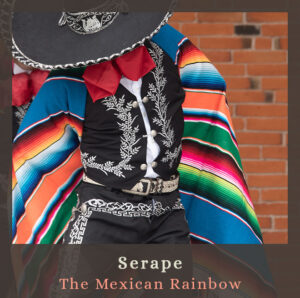Meet the fabulous ruana shawl! This unique & super-handy accessory has journeyed from the Andes mountains to the glamorous runways, captivating the hearts of fashion designers and fashion lovers worldwide.
In this blog post, we’ll explore the fascinating origins and modern adaptations of the ruana shawl, as well as offer styling tips and inspiration for incorporating this exquisite statement piece into your wardrobe, and we’ll even tell you how to make your own ruana!
Join us as we celebrate the magical charm of the ruana and its enduring allure that transcends time and place.
What is a Ruana Shawl
A ruana is a versatile garment that is a perfect blend of style and warmth. It’s basically a rectangular piece of woven fabric with a slit down the center that allows it to drape gracefully over the shoulders and flow effortlessly around the body.



Where do Ruanas come from?
Ruanas are originally from the Andean area in South America (Colombia and Venezuela). The traditional Ruana shawl is warm and often crafted from alpaca or sheep’s wool, which provides an unparalleled level of comfort and insulation for the intensely cold winters in those areas. The authentic ruana’s intricate patterns and vibrant colors are a testament to the rich history and artisanal craftsmanship of the Andean people. As a fashion designer, I am captivated by the ruana’s ability to elevate any ensemble with its timeless elegance and cozy sophistication!


What Types of Ruana Are Popular These Days?
Ruanas made a long way from their original design and purpose. Here are some of the options you got when looking for a ruana to enhance your look:
- Winter Ruana – Probably the most popular option on the list. From tweed to alpaca and merino wool, the warm ruana is available in endless styles, fabrics, designs & price ranges: You can easily find a beautiful piece that will add much warmth and style to your winter look.
- Summer Ruana – The summer ruana is a lightweight and stylish addition to any wardrobe. Usually made from breathable materials like cotton or linen, it drapes effortlessly over your shoulders, adding a unique chic to your outfit. This versatile accessory can be worn as a breezy cover-up at the beach, as an elegant addition to your outfit, or in MANY other different ways:
- Ruana with pockets – a modern interpretation that combines practicality and style in one chic garment. As one that has tasted the icy winters of the Himalayas, I find the ruana with pockets super handy when your hands are freezing, keeping you with a runway chic!
- Ruana with fringes – fringes are a popular addition for ruanas, available for both summer and winter ruana shawls. The fringes add a touch of bohemian flair to the classic design, with playful tassels that dance along its edges and create a flowing silhouette, simply beautiful.
Are ruanas in style in 2023?
2023-2024 runways show full interest in shawls, ponchos, and ruanas. As in any seasonal collection, the top designer who forecast and create the coming trends with their collections showed fascinating interpretations for the ruana. Fendi, Armani, Etro, Michael Kors, Kenzo, and many more surprised us with their fresh designs. Super oversized long shawls cover all ponchos and sophisticated ruanas in plain, plaid, striped, striking colors or with classic patterns as part of a formal suit or the finest casual outfit. These covers are here to take your style right up in the coming seasons, and you’ll be super updated…and super cozy!


How to wear a ruana?
The obvious way is to just put it over your (any) outfit and let it drape naturally, but just like the classic shawl or the poncho, the ruana is a super versatile garment that can be worn in many ways to achieve different styles and looks. Depending on your ruana and the occasion, you can make it work beautifully with a dress, coat, boots, high heels, and so much more; really, the options are endless!
I recommend you to experiment with various outfits and styles as these fab pieces can seamlessly flatter and blend in MANY ways.
Check out this tutorial to get some inspiration for a few stylish ways to drape, wrap, and tie your ruana!
How do you pronounce ruana properly?
Ruana is pronounced as roo-AH-nuh. The emphasis is on the second syllable, with “roo” like “room,” “AH” like “car,” and “nuh” like “nut.” Do not be embarrassed if it is taking you some time, as many struggled with it before you 🙂
Celtic Ruana vs. South-American Ruana
The Celtic ruana is an Irish-Scottish version of the classic ruana shawl, and its roots go way back too, as it’s highly associated with the beautiful medieval style.
In most cases, the Celtic ruana is made from heavy, warm materials and is often called a ruana cloak, and it sometimes comes with a hood too.
Celtic ruana cloak is either plain, plaid, or designed in other classic wool patterns such as tartan, while the South-American ruana is usually more colorful and features more intricate native designs.
What is the difference between a ruana and a kimono
This question arises since the ruana and the kimono can sometimes look just the same when they are worn in certain ways.
The primary difference between a ruana and a kimono lies in their origins, design, and cultural significance.
While the kimono is a traditional Japanese garment, characterized by its long, wide sleeves, straight seams, and T-shaped silhouette, the ruana is much more versatile, it has no sleeves or seams at all, it is a rectangular or square piece, with a slit for the head to go through, and open on the sides, providing a loose and flowing fit.

A kimono is usually crafted from silk or other fine materials and is adorned with intricate designs or patterns; it is worn wrapped around the body and secured with a sash called an “obi.”
As mentioned before, the ruana is a traditional Andean garment originating from the indigenous cultures of Colombia, Peru, Ecuador, and Bolivia and traditionally is made of woven warm fabrics like alpaca wool.
While both the ruana and kimono serve as outerwear, they represent distinct cultural identities and exhibit unique design elements that set them apart.
But, when worn open, the kimono looks just like a naturally draped ruana, and when worn as a wrap with a belt, the ruana performs in its majestic and looks just like a kimono.
What is the difference between a poncho and a ruana?
While ponchos and ruanas are quite similar and originate from the same continent, there are a few key distinctions between these two fashionable garments. The main one is that poncho typically have a central opening for the head, with a loose, unstructured body that drapes over the shoulders, offering a more casual and laid-back style. The ruana is an open-front garment, similar to a shawl (we’ll get to it soon!), with a more fluid and versatile design that can be wrapped.

According to ruggedandes.com, The original Andean ruana was designed to be thicker and heavier than the poncho, providing extra warmth to endure the high-altitude chill of the Andean mountains. However, that’s not really relevant anymore since modern ruanas and ponchos now come in an endless variety of materials for different levels of warmth, from summer to harsh winter.
What is the difference between a ruana and a shawl
A ruana is considered a type of shawl. The main difference between the ruana and the classic shawl is that the ruana has a front opening, allowing for slightly different styling options than the shawl, which is basically a large piece of fabric without openings.

Are ruanas unisex?
Absolutely, just like shawls and ponchos, ruanas are unisex garments. Of course, there are some designs that were made specifically for women, but most ruanas, when styled well, will flatter both men and women.
Does a ruana have sleeves?
No, a ruana does not have sleeves. If you’re looking for a garment with a similar draped look that includes sleeves, a cardigan or a kimono might be a great option, as ruanas, cardigans, and kimonos can look quite similar when worn in certain ways.
Does a ruana have pockets?
Sometimes! As mentioned, the ruana with pockets is a popular modern interpretation of the classic ruana design. And I find it beautiful & chic.
How to Make a Ruana
Creating your own ruana can be an amazing DIY project that allows you to choose the perfect fabric/yarn and personalize it to your taste.
There are 3 ways I can think about for making a Ruana:
#1 Just cutting!
That’s the most simple option. You gonna need a large piece of fabric, and While the process is relatively simple and easy, it does require some time to make it right, so be patient (:
To guide you through the steps, I’ve found an easy-to-follow video tutorial on YouTube that will make cutting your unique ruana a breeze. So, choose your fabric well, and enjoy making your one-of-a-kind statement piece!
☝️ Designer Tip:
If you don’t have a sewing machine to hem the fabric edges, or you just don’t want to bother about it, choose a fabric that allows it. Some types of wool and fleece do not need a hem and will work great.
#2 Crochet!
If you want to know how to crochet a ruana, I may not be the right person to ask 😊 I personally prefer sewing. However, ruana is a super popular garment to crochet, and the outcome is amazingly beautiful and satisfying. Here’s a video that gives accurate directions to make a thick warm ruana with a beautiful dense crochet pattern:
#3 Knit!
I love knitted fabrics, and I am an expert in choosing them for the garments I sew, but just like in crochet, I’m not an expert in making them 🙂 but the lovely lady on this video will provide you with all the needed info to knit yourself a gorgeous garment:
#4 Buy a pattern and work accordingly
I found one that looks great:
Pattern Instructions for Fleece Ruana.
Versatile and Chic: The Timeless Magic Charm of the Ruana
To sum it all up, the ruana shawl is a timeless and versatile garment that effortlessly bridges cultural history with the latest fashion trends. Its increasing popularity and endless styling possibilities make the ruana a must-have sophisticated and super comfortable addition to any wardrobe, winter, spring, summer, and fall for Women & Men!


















